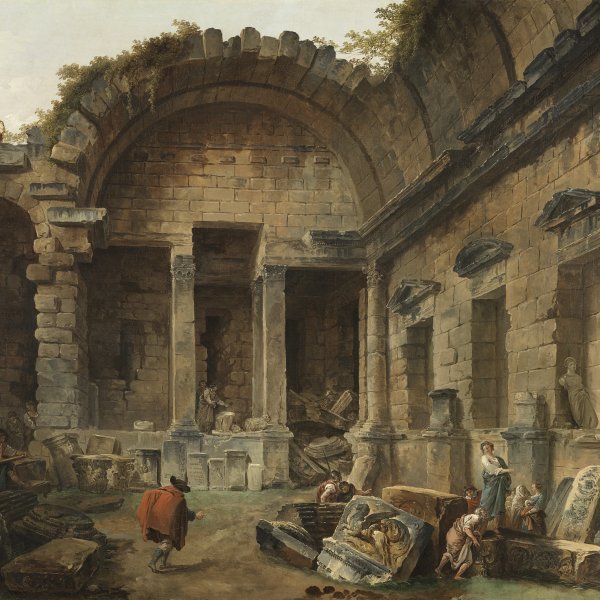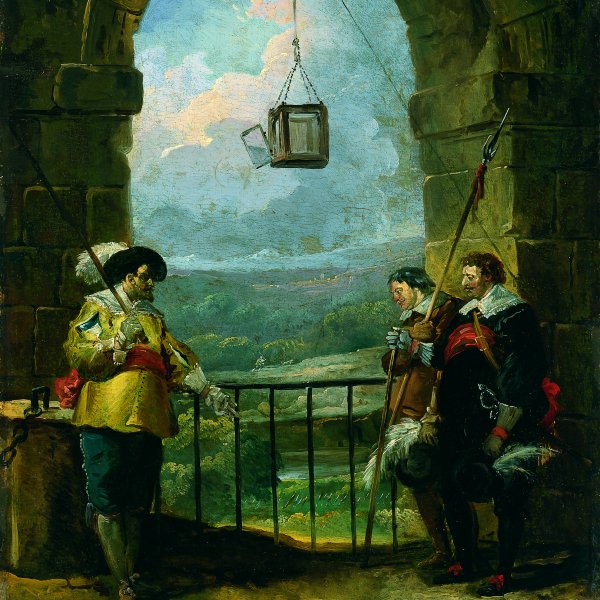The Foot-Bridge
ca. 1775
Oil on canvas.
59 x 47 cm
Museo Nacional Thyssen-Bornemisza, Madrid
Inv. no.
342
(1930.97
)
Room 24
Level 2
Permanent Collection
Hubert Robert was one of the most prolific and admired landscape and view painters of the 18th century. He was a tireless creator, admired by Diderot when he first exhibited at the Salon in 1767, although that critic subsequently criticised Robert for his hastiness and lack of care in his figures and compositions, defects due to the artist’s haste as a result of the high demand for his work. Robert’s passion for his work was evident during the year that he spent in prison between 1793 and 1794, first at Saint-Pélagie then at Saint-Lazare, during which time he continued to paint and draw.
Robert was the son of a valet de chamber of the Marquis de Stainville, a family that would be important to him as the Marquis’ son, the Duke de Choiseul, funded his early years. According to Mariette, Robert first trained with the sculptor René-Michel Slodtz and took part in the Expositions de la jeunesse in 1723 and 1724. In 1754 Robert travelled to Rome with his patron and was admitted to classes at the French Academy in that city. There the Academy’s director Natoire had the perception to appreciate one of Robert’s principal gifts, namely his ability to depict buildings and other architectural structures. Robert spent eleven years in Italy during which time he travelled, drew and organised the notebooks that would provide the basis for his work for the rest of his career. In Rome he was particularly attracted to the work of two artists, Giovanni Battista Piranesi and Giovanni Paolo Panini, who were outstanding for their depictions of architecture and who would influence the remainder of Robert’s output. Robert returned to Paris in 1765 and shortly after was admitted as a member of the Académie.
The Footbridge was in the collection of Count Gabriel du Tillet and was acquired by Hans Thyssen-Bornemisza from Wildenstein in New York in 1929. It was included in the exhibition held at the Neue Pinakothek in Munich in 1930 where it was reproduced in the catalogue with brief technical details. Years later it was briefly mentioned by Charles Sterling in the 1969 catalogue of the Collection. He dated the painting to around 1775 on the basis of the style of the figures’ clothes and the treatment of the leaves and branches. Sterling noted that the oval format might suggest that the canvas was a tableau de place and part of the decorative scheme of a room.
The canvas is one of the numerous scenes of gardens that Robert produced and which constituted an important area within his oeuvre, along with architectural views. This charming view features a rustic wooden bridge with a group of figures standing on it who have paused to look down into the water on whose bank an artist is working outdoors, a recurring motif in Robert’s work. The composition is a pleasing one, with a soft chromatic range deployed for important elements such as the sky, the water and the treetops, which harmonise with each other in a carefully selected range of blues, greys and greens, dotted with small areas of earth tones such as the leaves of the trees in the foreground as well as the immediate foreground nearest to the viewer.
Mar Borobia
Robert was the son of a valet de chamber of the Marquis de Stainville, a family that would be important to him as the Marquis’ son, the Duke de Choiseul, funded his early years. According to Mariette, Robert first trained with the sculptor René-Michel Slodtz and took part in the Expositions de la jeunesse in 1723 and 1724. In 1754 Robert travelled to Rome with his patron and was admitted to classes at the French Academy in that city. There the Academy’s director Natoire had the perception to appreciate one of Robert’s principal gifts, namely his ability to depict buildings and other architectural structures. Robert spent eleven years in Italy during which time he travelled, drew and organised the notebooks that would provide the basis for his work for the rest of his career. In Rome he was particularly attracted to the work of two artists, Giovanni Battista Piranesi and Giovanni Paolo Panini, who were outstanding for their depictions of architecture and who would influence the remainder of Robert’s output. Robert returned to Paris in 1765 and shortly after was admitted as a member of the Académie.
The Footbridge was in the collection of Count Gabriel du Tillet and was acquired by Hans Thyssen-Bornemisza from Wildenstein in New York in 1929. It was included in the exhibition held at the Neue Pinakothek in Munich in 1930 where it was reproduced in the catalogue with brief technical details. Years later it was briefly mentioned by Charles Sterling in the 1969 catalogue of the Collection. He dated the painting to around 1775 on the basis of the style of the figures’ clothes and the treatment of the leaves and branches. Sterling noted that the oval format might suggest that the canvas was a tableau de place and part of the decorative scheme of a room.
The canvas is one of the numerous scenes of gardens that Robert produced and which constituted an important area within his oeuvre, along with architectural views. This charming view features a rustic wooden bridge with a group of figures standing on it who have paused to look down into the water on whose bank an artist is working outdoors, a recurring motif in Robert’s work. The composition is a pleasing one, with a soft chromatic range deployed for important elements such as the sky, the water and the treetops, which harmonise with each other in a carefully selected range of blues, greys and greens, dotted with small areas of earth tones such as the leaves of the trees in the foreground as well as the immediate foreground nearest to the viewer.
Mar Borobia










